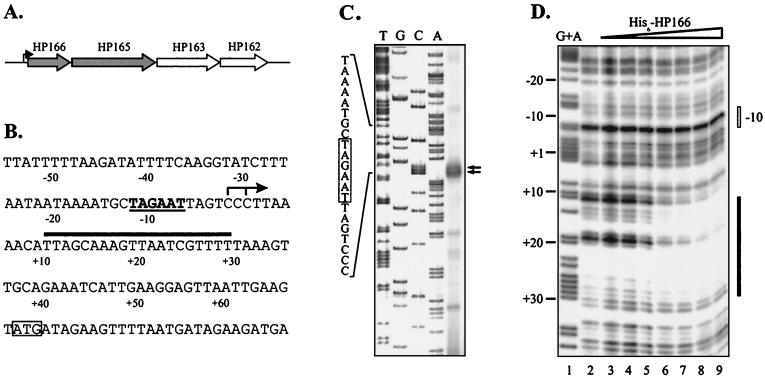FIG. 1.
(A) Schematic representation of the operon encoding response regulator HP166 and the cognate histidine kinase HP165. In the genome sequence of H. pylori 26695 the histidine kinase gene is annotated as two separate ORFs, HP165 and HP164, probably due to a sequencing error. The arrow indicates the PHP166 promoter. (B) Schematic representation of the PHP166 promoter. The transcriptional start point is indicated by an arrow, and the −10 promoter element is underlined. The translational start codon is enclosed in a box. The binding site of response regulator HP166 is indicated by a solid bar. The numbers below the sequence indicate positions relative to the transcriptional start site. (C) Determination of the transcriptional start site of ORF HP166 by primer extension analysis. Total RNA extracted from H. pylori G27 was hybridized to radiolabeled oligonucleotide HP166PE. Transcriptional start points are indicated by arrows. A part of the promoter sequence is shown on the left. The −10 promoter element is enclosed in a box. The sequence reaction (lanes A, C, G, and T) was performed by using oligonucleotide HP166PE and plasmid pSL-166PE as the template. (D) DNase I footprint analysis of His6-HP166 on the PHP166 promoter. A specific 308-bp end-labeled BamHI-EcoRI fragment was incubated with different amounts of His6-HP166. In lanes 2 to 9 0, 1, 2, 4, 6, 8, 10, and 12 μg of His6-HP166 incubated with acetylphosphate were added. The numbers on the left indicate nucleotide positions with respect to the transcriptional start site. The solid bar on the right indicates the area of DNase I protection. The open bar indicates the position of the −10 promoter element. Lane 1 contained a G+A sequence reaction mixture with the DNA probe used as a size marker (27).

